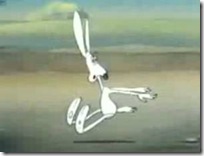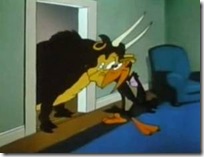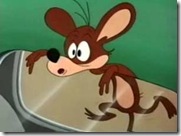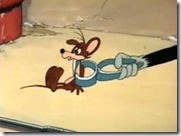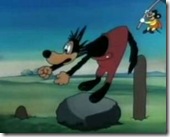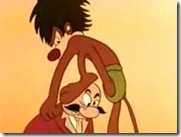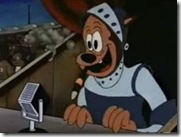OK, Dan Gordon fans...this is an article I wrote for the July 2008 issue of The Comics Journal. Since that issue is long off the stands, I want to share it here for those who missed it. The best part about publishing it HERE is all the links you can follow to read and watch the brilliant cartoon artistry of Dan Gordon.
"Dan Gordon -
A Brush With Greatness"
In the late 1940’s, “Funny Animals” and “Teen Humor” were two of the most popular categories in the ever-growing world of comic books.
Dan Gordon not only became a master of both genres, he actually combined the two in the world’s first funny-animal teen-humor title, Hi-Jinx |  |
Coming from the highly-collaborative world of animation, story-man and director
Dan Gordon found that in comic books, he was finally able to have full control over his cartoon creations. His well-honed story skills were met by his quickly-accelerating drawing chops to produce some of liveliest and funniest comic book stories ever pressed to paper.
ACG Comics images © Roger Broughton 2009
 | With the freedom to use his own characters and comic sensibilities, he cut loose on the comics page (in those pre-code days) without the editorial interference that comes with licensed characters and bigger publishers. |
Dan Gordon clearly reveled in the opportunity to get his undiluted cartoon ideas in print. You can see it in all of the comics he draws...
- in the dynamic spontaneity of his deft brush strokes
- in the beautifully bold shadows that give the characters weight and make them pop.
- in the dynamic staging that gives the scenes depth and allows the characters to move.
- in the way he lovingly renders even the backsides of all the characters’ heads!
Biography and Cartoonography

Dan Gordon began his animation career as a story man at New York’s Van Beuren Studios, and by 1936 he was receiving a director’s credit there. When Van Beuren went under, Gordon and many of his colleagues went to work for Paul Terry’s Terrytoons
1. It was here that Dan Gordon worked with Joe Barbera (another Van Beuren alum) on “Pink Elephants,” a cartoon that Barbera described as one of ”…the first cartoons I had a hand in actually creating from the beginning
2.”

Click image to Watch Pink Elephants cartoon in new window
Dan Gordon and Joe Barbera headed out west to MGM in 1937
3, but Gordon bolted back to the east shortly thereafter to help re-write the troubled Gulliver’s Travels animated feature film at Fleischer Brothers’ Studios
4. Gordon’s re-writes couldn’t save Gulliver, but Dan Gordon was instrumental in the success of the Fleischer Studio’s next hit: the 1940’s Superman theatrical animated shorts. Dan Gordon served both as writer and director on many of those timeless cartoon classics.
When Paramount seized control of the Fleischer studio in Miami,
Dan Gordon was one of four directors put in charge of production
5. Gordon stayed only a couple years at the newly-dubbed Famous Studios, but the few Popeye shorts he directed are quite remarkable. Cartoons like
A Jolly Good Furlough and
Seein' Red, White 'N' Blue are completely manic in their cartoony intensity, and stand apart from the usual Popeye-Olive Oyl-Bluto love triangle stories.
1943’s Popeye cartoon
The Hungry Goat stands out even more because Popeye is not even the hero of this picture!
 |
For reasons that remain unclear, Dan Gordon left Famous Studios -- and the animation field
-- in 1944.
The fast-paced, hyperkinetic, and over-caffeinated mayhem of those Popeye cartoons leads right into the comic book stories he crafted for The American Comics Group (ACG). |
Dan Gordon was part of a group of animation pros led by Jim Davis (of
Fox and Crow fame) that supplied original funny animal comic book stories to ACG and DC comics. Dan’s work began appearing in Giggle comics in 1944, and by Giggle #9, he introduced long-running character,
Superkatt.
ACG Comics images © Roger Broughton 2009
Superkatt is a funny-animal jab at the “long-underwear” genre of superhero comics. The title character doesn’t have any super powers at all, but is a normal (talking) house cat that dresses in a diaper, a baby’s bonnet, and a big blue bow to fight minor neighborhood injustices. In 1949 came
Funny Films, a funny animal anthology title that tried to convince the reader that its stories were the filmed exploits of famous Hollywood cartoon characters.
Gordon’s
Puss and Boots was a dog-and-cat version of Tom and Jerry on crack, with unbridled cartoon violence its only delicious theme. Gordon’s other
Funny Films character was the comical rabbit inventor,
Blunderbunny. In LaSalle Comics’
Hi-Jinx, he experimented with the hybrid idea of “Teen-Age Animal Funnies.”
His final major character from this era is Cookie O’Toole, the teen-age star of
Cookie comics. Cookie began his run in 1945 when he and his whole gang (best friend/hipster Jitterbuck, heartthrob Angelpuss, sharp-dressed rival Zoot, and their egghead pal, “The Brain”) appeared fully-formed in a one-shot issue of
Topsy-Turvy Comics. By the next year,
Cookie had his own title, and began a run that lasted nine years and fifty-five issues.
Cookie is a rare example of a knock-off surpassing its inspiration. The explosive popularity of MLJ Comics’ “
Archie” in the mid-1940’s gave birth to an entire comics genre: the teen humor comic. While the Archie gang is clearly more iconic and enduring than Cookie and his pals ever hope to be, the Cookie comics are a much more entertaining read.
Dan Gordon continued to make comics for
ACG and related companies like LaSalle until he was called back into animation service by his old pal
Joe Barbera.
Bill Hanna and Joe Barbera had been creating the classic Tom and Jerry cartoons at MGM since 1940, but by 1957 the studio’s animation division was shut down
6. In a desperate bid to stay alive in the new TV era, Hanna and Barbera struck out on a foolhardy mission to make a weekly animated television series for a tiny fraction of their old Tom and Jerry budgets
7.
Dan Gordon jumped on board to help out at H-B Enterprises, and (with partner Charles Shows) was soon writing and drawing storyboards for most of the episodes of those earliest, foundational HB cartoon classics:
8 Huckleberry Hound, Yogi Bear, Pixie & Dixie, Quick Draw McGraw and Augie Doggie.
| 
 |
Emboldened by their early success in Saturday-morning, Hanna and Barbera set their sights on producing a prime-time domestic comedy with a prehistoric twist. Gordon had some experience with cartoon cavemen, having worked on the
“Stone Age” series of animated shorts for the Fleischer Brothers Studio back in 1940
9.
Although many talented people had a part in creating what would become The Flintstones, Bill Hanna generously points to our man Dan. "Now you may not get the same response from anybody else," Bill Hanna recalls, "but to me,
Dan Gordon is responsible for the Flintstones. He came up with the basic concept of doing it with cavemen in skins."
10 And
Joe Barbera recounts in his autobiography that, ”
The first two Flintstones were the work of Dan Gordon and myself; I controlled the content, and
Dan did the storyboards.”
11

Storyboards by
Dan Gordon for
The Flintstones
With the advent of eBay, online comic shops and cartoon/comics blogs, today’s Dan Gordon fan has a pretty decent chance of finding some of his amazing comics at a reasonable cost. Well-worn back issues of Giggle, Ha-Ha, and Cookie comics are fairly easy to find, and many fans have been scanning and sharing these public-domain stories online.


Until someone compiles these comics into a nice reprint volume, they’re mostly just a few Google searches away. But to see some of the beautifully bold brushwork of
Dan Gordon’s only solo cartooning, just click on some of the links and images in this biographical sketch, and get ready to have fun.
1 Of Mice and Magic by Leonard Maltin, Pg 134
2 My Life in ‘Toons by Joe Barbera, Pg 56
3 Of Mice and Magic by Leonard Maltin, Pg 136
4 Talking Animals and Other People by Shamus Culhane, Pg 205
5 Beck, Jerry.
Fleischer Becomes Famous Studios
6 Don Markstein, http://www.toonopedia.com/mgm.htm
7 Bill Hanna A Cast of Friends Pg 84
8 The Flintstones: A Modern Stone Age Phenomenon by T.R. Adams, page 37
9 http://www.bcdb.com/cartoons/Paramount_Pictures/Fleischer_Studios/Stone_Age/
10 Bill Hanna as quoted in The Flintstones: A Modern Stone Age Phenomenon Pg 28
11 My Life in Toons by Joe Barbera Page 136
12 Bill Hanna as quoted in The Flintstones: A Modern Stone Age Phenomenon Pg 37
"I, Sherm Cohen, am the author of this article, "Dan Gordon -A Brush With Greatness," and I release its content under the terms of the GNU Free Documentation License, Version 1.2 and later."



 Suffice to say that it was reading Harvey Kurtzman's Jungle Book hardcover back in 1986 that got me back into drawing after a nasty period of burn-out. Kurtzman got me excited about funny comics at a time when there wasn't much to get excited about. I found out about his brilliant Hey Look comics later that year when I found a beat-up copy of Kurtzman Comics at Hi-De-Ho comics in Santa Monica. That little 32-page underground comic included Pot-Shot Pete and a variety of Hey Look pages.
Suffice to say that it was reading Harvey Kurtzman's Jungle Book hardcover back in 1986 that got me back into drawing after a nasty period of burn-out. Kurtzman got me excited about funny comics at a time when there wasn't much to get excited about. I found out about his brilliant Hey Look comics later that year when I found a beat-up copy of Kurtzman Comics at Hi-De-Ho comics in Santa Monica. That little 32-page underground comic included Pot-Shot Pete and a variety of Hey Look pages. 

